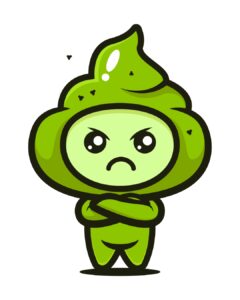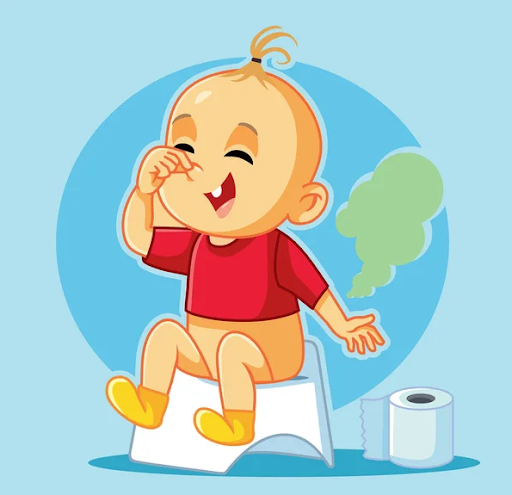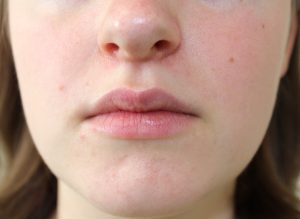Despite the initial shock of opening a diaper to find green, it is common in infants. The good news is that occasional changes in poop color are usually nothing to worry about (LeWine, 2024). Many things can affect stool color, from diet to digestion speed, so don’t panic right away.
 Why Is My Child’s Poop Green?
Why Is My Child’s Poop Green?
Green poop in children is not usually a cause for concern unless it becomes persistent.
If your child has been eating a lot of dark green vegetables or is quickly passing green bile through their system, their poop may take on a green color (LeWine, 2024). This is entirely normal, especially in babies. Green-colored stools are common in infants and considered part of the normal range of poop colors (Solasaari et al., 2024).
Dark Green Poop in Formula-Fed Babies
Formula-fed babies are slightly more likely than breastfed babies to have green stools, sometimes due to excess iron from fortified formulas or supplements (LeWine, 2024).
The Role of Bile
Bile is one of the main reasons poops can appear green (LeWine, 2024). This brownish-green liquid, produced by the liver, helps digest fats and break down food. If food moves quickly through the gastrointestinal (GI) tract, as with diarrhea, bile doesn’t have time to break everything down fully. This can leave more green pigment in the stool.
When to Consult Your Pediatrician
Occasional green baby poop is normal. However, if it lasts for more than five days, it is worth checking in with your pediatric provider to rule out other digestive issues.
Green Poop & Diarrhea
When a child has diarrhea, the color of the stool often reflects what they have recently eaten. For example, if your child ate blue Jell-O and then developed diarrhea, the stool may appear blue. Breastfed babies usually have looser stools that range from yellow to green (Schmitt, 2017). However, there is a difference between normal loose stools and diarrhea.
Signs that your baby may have diarrhea include:
- More frequent pooping than usual
- More mucus than normal
- Blood in the stool
- Strong, foul odor
- Signs of dehydration (see below)
Because diarrhea causes fluid loss, dehydration is the most critical complication to watch for, especially in infants (Schmitt, 2017).
Signs of Dehydration in Babies
- Few or no wet diapers
- Very dark yellow urine
- Sunken soft spot (fontanelle) on the head
- Dry mouth or tongue
- Dry eyes or crying without tears
- Slow blood refill: press a fingernail until it turns pale, release, and count. If it takes more than two seconds to turn pink again, dehydration may be present.
If you notice these signs, call your pediatric provider and review guidelines on when it is best to go to the ER.
How Prebiotics, Probiotics, and Synbiotics Can Help
Some parents turn to formulas or supplements containing prebiotics, probiotics, or synbiotics to support digestive health. Research shows these can improve bowel patterns by boosting beneficial gut bacteria, softening stools, and increasing the frequency of bowel movements (Qian et al., 2025).
However, products vary widely, and more research is needed to confirm the benefits of specific formulations for infants (Lemoine et al., 2022). Before starting any supplement, discuss it with your pediatrician to ensure it’s safe and appropriate for your child.
 When to Immediately Contact Your Pediatric Provider
When to Immediately Contact Your Pediatric Provider
Call your provider if your child has green poop and:
- Fever
- Vomiting
- Refusal to eat
- Signs of dehydration (few wet diapers, dark urine, no tears, sunken fontanelle)
- Decreased activity or unusual sleepiness
Green poop is usually just a harmless sign of diet or digestion speed, but persistent green stools and diarrhea with dehydration might require a visit to your provider. Trust your instincts, keep an eye on symptoms, and when in doubt, check in with your pediatric provider.
Consultation and Guidance for Child Digestive Health
Occasional green poop is normal, but addressing persistent color changes, diarrhea, or complex gut issues requires a deeper look. Through pediatric functional medicine, our practitioners at GHT Kids don’t just treat symptoms – we find the root cause. Schedule your consultation today to get personalized guidance, rule out underlying issues, and gain confidence in nurturing your child’s healthy digestion.
References
Jana, L., & Shu, J. (2021, March 18). The Many Colors of Baby Poop. HealthyChildren.Org. https://www.healthychildren.org/English/ages-stages/baby/Pages/The-Many-Colors-of-Poop.aspx
Lemoine, A., Tounian, P., Adel-Patient, K., & Thomas, M. (2022, December 24). Pre-, pro-, syn-, and Postbiotics in Infant Formulas: What Are the Immune Benefits for Infants? Nutrients 2023, 15(5), 1231. https://doi.org/10.3390/nu15051231
LeWine, H. E. (2024, April 1). Green poop: What stool color can indicate about health. Harvard Health. https://www.health.harvard.edu/staying-healthy/green-poop-what-stool-color-can-indicate-about-health
Qian, J., Fang, Z., Chang, S., Zeng, Z., & Zhang, J. (2025). Effectiveness and safety study of formula containing probiotics, prebiotics, synbiotics on fullterm infants’ growth—A systematic review and meta-analysis of randomized controlled study. European Journal of Clinical Nutrition, 79(6), 504–511. https://doi.org/10.1038/s41430-024-01506-9
Schmitt, B. (2017, June 24). Diarrhea (0-12 Months). HealthyChildren.Org. https://www.healthychildren.org/English/tips-tools/symptom-checker/Pages/symptomviewer.aspx?symptom=Diarrhea+(0-12+Months)
Solasaari, T., Korpela, K., Lommi, S., Hyvönen, S., Gardemeister, S., Merras-Salmio, L., Salonen, A., de Vos, W. M., & Kolho, K.-L. (2024). Bowel function in a prospective cohort of 1052 healthy term infants up to 4 months of age. European Journal of Pediatrics, 183(8), 3557–3565. https://doi.org/10.1007/s00431-024-05625-0




